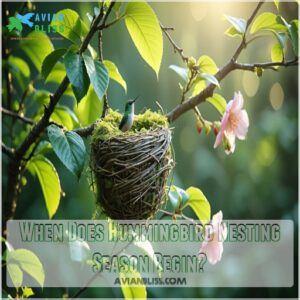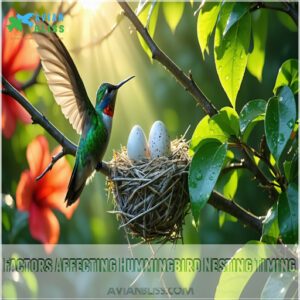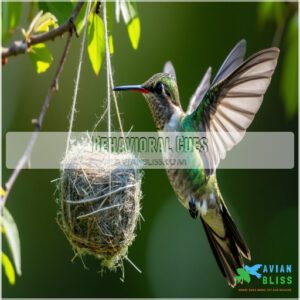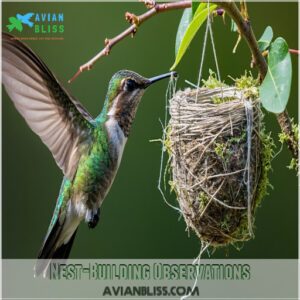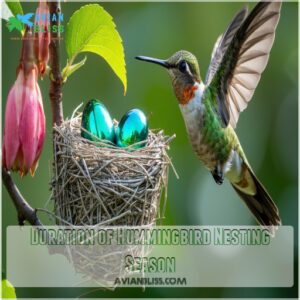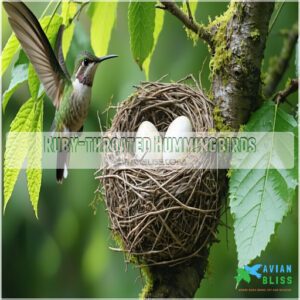This site is supported by our readers. We may earn a commission, at no cost to you, if you purchase through links.
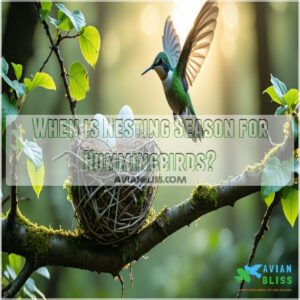 Hummingbird nesting season usually kicks off in early spring, but it depends on where you live. In warmer areas like the southern U.S., it can start as early as March, while cooler regions might not see nests until July.
Hummingbird nesting season usually kicks off in early spring, but it depends on where you live. In warmer areas like the southern U.S., it can start as early as March, while cooler regions might not see nests until July.
Some lucky spots, like coastal California, enjoy year-round nesting thanks to mild weather.
Watch for females gathering soft materials like spider silk and moss to build their tiny, delicate nests on thin branches. These nests are so small they’re easy to miss—about the size of a golf ball or smaller!
Curious about what makes their nests so special? There’s more to uncover, including the fact that they use soft materials like spider silk and the nests are built with a delicate design.
Table Of Contents
- Key Takeaways
- When is Nesting Season for Hummingbirds?
- When Does Hummingbird Nesting Season Begin?
- Factors Affecting Hummingbird Nesting Timing
- Hummingbird Nesting Season by Region
- Signs of Hummingbird Nesting Activity
- Duration of Hummingbird Nesting Season
- Nesting Habits of Common Hummingbird Species
- Multiple Broods and Re-nesting Patterns
- Supporting Hummingbirds During Nesting Season
- Frequently Asked Questions (FAQs)
- When do hummingbirds start nesting?
- What is hummingbird nesting season?
- How long does a hummingbird nest for?
- When should hummingbirds put out nest materials?
- When do hummingbirds lay eggs?
- When do hummingbirds nest in Delaware?
- How do you know if hummingbirds are nesting?
- How many times a year do hummingbirds have babies?
- What day do you take hummingbird feeders down?
- What kind of tree does a hummingbird nest in?
- Conclusion
Key Takeaways
- Nesting season for hummingbirds varies by location, starting as early as November in warm regions like California and peaking between March and July in most areas.
- Females craft nests using spider silk, moss, and plant fibers, often hidden on thin branches about a foot from the trunk for camouflage.
- Most hummingbirds raise 1-3 broods per year, with each nesting cycle lasting about 40-50 days from building the nest to chicks fledging.
- You can help by providing nesting materials like moss and cotton, and maintaining native flowering plants and clean feeders in your yard.
When is Nesting Season for Hummingbirds?

Hummingbird nesting season kicks off in early spring, though the exact timing depends on where you live. In warmer spots like the southern U.S., it starts as early as March, while in cooler regions, it can stretch into July.
Some lucky areas, like coastal California, even have hummingbirds nesting year-round! Their breeding patterns are influenced by geography, climate, and species.
Ruby-throated hummingbirds, for instance, nest between April and August in the Eastern U.S. Watch for hummingbird nesting behavior like feisty territorial displays or nest construction.
Using spider silk, moss, and plant fibers, females build tiny, cup-shaped nests perfect for egg incubation and eventual fledgling care. It’s fascinating to watch hummingbird nesting!
When Does Hummingbird Nesting Season Begin?
As winter fades, the hummingbird breeding season begins, and nesting season springs to life.
Depending on where you live and the species, you’ll notice females starting to collect nesting materials like spider silk, moss, and lichen.
These miniature builders craft well-hidden, cup-shaped nests that are sturdy yet flexible.
A baby hummingbird’s development is a fascinating process.
Nest construction is an impressive feat, often taking several days of non-stop effort.
Watching their nesting behavior is fascinating—females dart back and forth, painstakingly piecing together materials to form their perfect nest.
Whether perched on thin branches or tucked among leafy cover, these nests are so well camouflaged they’re tough to spot.
Keep an eye out, though—it’s the first sign that hummingbird nesting season is underway!
Factors Affecting Hummingbird Nesting Timing
Hummingbirds don’t all nest at the same time, and their schedules can change based on where they live, the weather, and their species.
By understanding these factors, you’ll see how nature keeps them adaptable and ready for nesting success.
Geographic Location
Your location plays a big role in hummingbird nesting season. Coastal areas, like parts of California, often see earlier nesting thanks to their mild climate zones.
In contrast, mountainous regions or colder states might delay nesting until conditions improve. Regional variations matter—hummingbirds in urban landscapes may even adapt to nest on wires!
Geographic variation determines the best nesting locations for different species. Wherever you’re in the United States, keep an eye out for these seasonal shifts.
Climate and Weather Conditions
Changes in weather patterns and temperature extremes can throw off nesting season timing.
Shifting climate zones and humidity levels often force hummingbirds to adapt quickly, impacting their incubation period and nesting efforts.
You’ve probably noticed earlier migrations or disrupted schedules.
Longer sunshine duration or unpredictable cold snaps create unique challenges.
- Rising temperatures cause earlier nest-building.
- Extreme weather delays nesting schedules.
- Climate change alters habitats drastically, and this is a critical factor in climate change and its effects on nesting season, making earlier migrations more common.
Species-Specific Variations
Different hummingbird species have unique nesting habits influenced by their biology and environment.
Here’s what sets them apart:
- Nest Size: Ranges from thimble-sized to as large as a golf ball.
- Materials: Spider silk, lichen, and plant fibers, sometimes mixed with surprising finds like yarn.
- Location: High tree branches or even patio lights.
- Breeding Habits: Some reuse nests, while others start fresh yearly.
Hummingbird Nesting Season by Region
Hummingbird nesting seasons vary widely based on where they live. In warmer southern parts of the U.S., nesting kicks off as early as March. In cooler northern areas, it doesn’t usually begin until July.
Some species stick to coastal regions, like Anna’s Hummingbirds in California, where a mild climate allows nesting almost year-round. Hummingbirds prefer nesting in deciduous trees near a source of water.
In the eastern United States, nesting season often stretches from April through August. Climate impacts when hummingbirds nest, with species adapting to local weather. For example, milder winters in coastal areas produce longer nesting schedules, while harsher climates narrow the window.
Geographic variations like elevation and plant diversity also matter—a garden full of native flowers improves both their nesting habits and survival. Paying attention to regional nesting schedules helps you support these tiny wonders during their perfect season.
Signs of Hummingbird Nesting Activity
You’ll know hummingbirds are nesting when you spot females collecting soft materials like moss, lichen, or spider silk.
Keep an eye out for them hovering near thin branches, where their tiny, well-hidden nests are often tucked away, made with materials like lichen.
Behavioral Cues
You’ll know it’s nesting season when hummingbirds get a bit bossy and secretive.
Look for these behaviors:
- Aggressive Chasing: Males guard their turf fiercely, chasing rivals to secure food and nesting spaces.
- Courtship Displays: Watch males perform dramatic swoops and dives to impress potential mates during the mating season.
- Nest Prep Work: Females gather spider silk, plant fuzz, and lichen while shuttling between feeding and nest sites.
These nesting habits and social interactions often mark the start of the hummingbird breeding period.
It’s like they’re throwing tiny housewarming parties!
Nest-Building Observations
After spotting behavioral cues, start watching for hummingbird nest building in action. Females gather nest materials like spider silk, moss, and lichen—nature’s perfect adhesive and camouflage techniques.
Look for frequent visits to thin branches, usually a foot away from the tree trunk, as they carefully craft their tiny cup-shaped nests. These impressive little homes, often no bigger than a quarter, blend so seamlessly into their surroundings that finding one feels like winning a scavenger hunt.
With their rapid back-and-forth trips, female hummingbirds compress the materials using their wings and plumage. The nesting season showcases their expert construction methods and knack for nest shapes suited for survival.
Duration of Hummingbird Nesting Season
Ever wonder how long the magic of hummingbird nests lasts? The nesting season spans 4-5 months, but individual hummingbird nests stay active for about 40-50 days.
Hummingbirds exhibit unique flight capabilities.
Here’s the timeline:
- Nest construction: 7-10 days of crafty weaving using spider silk and plant fibers.
- Incubation periods: Eggs hatch after 16-18 days.
- Nestlings: Tiny birds grow for 18-22 days.
- Fledging times: They leave but need 1-2 weeks of care.
Observing a mother’s dedication during their breeding cycles is awe-inspiring, highlighting her clever nesting patterns and effort in raising her young.
Nesting Habits of Common Hummingbird Species
You’ll find that different hummingbird species have unique nesting habits, from the materials they use to where they build their tiny, camouflaged nests.
Ruby-throated, Anna’s, and Allen’s Hummingbirds all follow fascinating patterns, crafting nests as small as a quarter but strong enough to hold growing chicks, showcasing their remarkable nesting habits.
Ruby-throated Hummingbirds
Ruby-throated Hummingbirds work magic with their tiny nests. These thumb-sized cups, nestled on delicate tree branches near water, are crafted using spider silk, lichen, and plant fibers.
Female hummingbirds typically lay two eggs per clutch, about the size of navy beans. Only an inch wide, the nests stretch as chicks grow—nature’s ingenuity at its best.
Curious about their cozy construction? You can learn more about hummingbird nest construction.
Here’s a breakdown:
| Feature | Dimensions | Materials | Preferred Location | Purpose |
|---|---|---|---|---|
| Size | ~1 inch diameter | Spider silk | Deciduous trees | Flexibility and durability |
| Construction Time | 7 days | Plant fibers | Near water | Secure nesting for eggs |
| Camouflage | Blends with lichen | Lichen | Branch, ~1 foot from trunk | Protects against predators |
| Anchors | Spider silk | Spider silk | Thin branches | Holds nest tightly |
| Shape | Tiny bowls | Soft fluff | Nectar-rich surroundings | Comfortable home for chicks |
This nesting season, observe their artistry!
Anna’s Hummingbirds
Anna’s Hummingbirds are skilled architects, crafting hummingbird nests with spider silk, plant fibers, and moss. These nest construction experts often recycle old nests, adding new layers.
Found 6-20 feet high, they blend effortlessly with lichen-covered branches.
Their breeding cycles allow nesting even in winter, thanks to mild climates.
Curious about when do hummingbirds nest? For Anna’s, the nesting season can start as early as November!
Allen’s Hummingbirds
In December, Allen’s Hummingbirds begin nesting in warmer areas, constructing tiny, well-camouflaged nests. These marvels use spider silk and plant fibers to anchor their creations.
Here’s what you’ll notice:
- Each nest is about the size of a penny.
- Females lay two small, white eggs resembling coffee beans.
- Baby hummingbirds hatch in 18 days, fledging within three weeks.
Multiple Broods and Re-nesting Patterns
Hummingbirds often amaze us with their determination during the nesting season. In warmer areas, they frequently raise multiple broods, sometimes even three!
When conditions are right—like abundant food and mild weather—early nesters have time for more breeding cycles. Females may reuse hummingbird nests to save energy or start from scratch if the first nest fails.
Renesting patterns depend on timing and resources, as they aim for successful fledging rates. Understanding nesting site selection is essential for the survival of hummingbird chicks.
- Key Facts about Multiple Broods:
- Warm climates encourage larger brood sizes.
- Early starters can raise more broods.
- Females often adapt materials for nest reuse.
- Renesting happens after failed attempts.
- Weather impacts breeding cycles and fledging rates.
Supporting Hummingbirds During Nesting Season
You can help hummingbirds during nesting season by making your yard a safe and welcoming space.
Providing food, water, and nesting materials supports these tiny birds as they build their delicate homes and raise their chicks.
Creating Suitable Nesting Habitats
To create a perfect nesting habitat, think like a hummingbird architect! Offer nest materials like spider silk for flexibility, moss and lichen for camouflage, and plant fibers for insulation.
You can purchase hummingbird nesting supplies online.
Focus on tree selection—deciduous trees near water work best. Nest placement matters too; they prefer thin branches about a foot from the trunk.
Camouflage techniques, like using soft down or nearby foliage, guarantee hummingbird nests remain cozy and hidden during nesting season.
Providing Food and Water Sources
To support hummingbirds during nesting season, focus on providing reliable food and water sources. Native flowering plants with nectar-rich, tubular blooms are a hummingbird’s dream buffet.
Keep hummingbird feeders clean and full of fresh nectar—just avoid harmful additives like red dye. Consider a quality hummingbird feeder to attract these delightful birds.
Add inviting water features, like misters or shallow baths, for drinking and cooling off.
- Plant colorful blooms: Think vibrant reds, oranges, or purples.
- Use shady spots for feeders: This keeps nectar fresh longer.
By creating an oasis, you’ll keep these tiny birds buzzing with energy all season!
Frequently Asked Questions (FAQs)
When do hummingbirds start nesting?
Nesting starts as early as late November in warmer regions, like California, with peak activity from March to July.
It depends on the species and climate, but females build nests when food sources are plentiful.
What is hummingbird nesting season?
It’s like nature’s clockwork—hummingbird nesting stretches from late November in warm regions to May in cooler ones.
Species and location matter, but these tiny architects synchronize with spring blooms, ensuring food for their young.
How long does a hummingbird nest for?
A hummingbird typically nests for 18-21 days during incubation, then another 14-21 days while feeding its chicks until they fledge.
So, you’re looking at around five to six weeks in total.
When should hummingbirds put out nest materials?
Only about 20% of hummingbird nests survive predators.
So put out soft materials like cotton, moss, or pet fur by late fall or early winter.
This helps females prepare early in warmer regions.
When do hummingbirds lay eggs?
Female hummingbirds lay their eggs during the nesting season, varying by species.
Most lay two tiny white eggs in a camouflaged nest.
Incubation lasts 14-21 days, ensuring chicks develop in safe, well-hidden spots.
When do hummingbirds nest in Delaware?
You’ll find hummingbirds nesting in Delaware primarily from late spring to early summer, usually between May and July.
These tiny birds prefer hidden, well-camouflaged spots near nectar-rich flowers and water sources to build their delicate nests.
How do you know if hummingbirds are nesting?
You’ll notice subtle signs—females frequenting the same spot, small bowl-shaped nests in trees or bushes, and a flurry of tiny wings.
Stay observant; they’re quiet and cryptic, blending perfectly with their surroundings.
How many times a year do hummingbirds have babies?
Most hummingbirds raise 1-3 broods per year, depending on the species and climate.
Females can raise up to three broods in warmer areas, with each nesting cycle lasting about a month from eggs to fledglings.
What day do you take hummingbird feeders down?
Better safe than sorry—take down hummingbird feeders about two weeks after you’ve seen the last one in fall.
This guarantees late migrators have energy for their journey without causing unnecessary dependency.
What kind of tree does a hummingbird nest in?
Hummingbirds prefer to nest in the thin branches of deciduous trees like oak, birch, or poplar.
They choose spots near nectar-filled flowers or water sources, keeping nests camouflaged with lichen, moss, and spider silk.
Conclusion
Think hummingbird nesting season is just a spring fling? Think again! These tiny architects tailor their timing to your region, from early March in the South to July in cooler areas.
If you’re in coastal California, lucky you—year-round nesting awaits. Watch for females using spider silk and moss to craft golf-ball-sized nests.
Knowing when nesting season for hummingbirds begins helps you support these incredible creatures by providing safe habitats and food. They’ll thank you with their mesmerizing presence!
- https://www.perkypet.com/advice/bird-library/hummingbird/annas-hummingbird/nesting
- https://abcbirds.org/blog21/amazing-facts-hummingbird-chicks/
- https://www.rubythroat.org/rthureproductionmain.html
- https://www.birdsandblooms.com/birding/attracting-hummingbirds/hummingbird-nest-facts/
- https://santamonica.wbu.com/hummingbirds-are-nesting

